Iloca RapidA German viewfinder camera made in the 1950s by Wilhelm Witt. There were several variants of this camera as well as a Rapid B rangefinder version. The Rapid has a unique left-side wind lever that allows winding with the left hand while firing the shutter with the right hand. Hence the "rapid" designation. Apart from the winder, this is a fairly typical scale-focusing viewfinder camera from the 1950s. It has one of the AGC shutters, (Prontor, Pronto or Vero), and Steinheil Munchen triplet lens (Cassar or Cassarit). This particular camera has a Cassar lens and Vero shutter. The lens on my camera was cracked so I wasn't able to take any pictures with it. However, I've used other cameras with this lens and it produces good pictures. To open the back, lift the rewind knob as far as it will go and turn the knob clockwise. This will activate a spring that pops open the back. |

|
 |
To remove the top cover, look closely at the film counter dial and you see a spring clip holding the dial in place. Remove the spring clip with a small screwdriver or pick. The dial then can be lifted off. Usually the dial is a tight fit and won't fall out. I use a piece of masking tape to lift the dial up far enough to get a screwdriver underneath the dial. The dial is very soft aluminum and easily scratched, so it's not a good idea to try and pry it out directly. Remove the screw underneath the counter dial. |
 |
Open the back then hold the rewind fork while unscrewing the rewind knob. The film reminder cover on the rewind knob can stay on. If you need to remove it for cleaning, remove the spring clip like the one on the film counter dial. |
 |
Remove the spring clip around the rewind shaft and lift the wind lever off. Remove the screw found under the wind lever and the top cover will then lift off. As always, watch for shim washers and the shutter release button that will fall out The viewfinder is held in place against the top cover by spring metal pieces. Remove the springs and the parts to the viewfinder will come loose. |
 |
With the top removed you can see the winder mechanism spread across the top of the camera. Usually this can be cleaned if needed without disassembly. To wind the camera with the top cover off, just replace the wind lever on the rewind shaft tube. Note the three tabs on the bottom of the wind lever that fit into slots in the large cam around the rewind shaft base. |
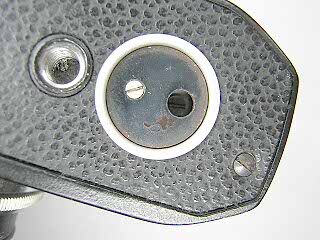 |
To remove the bottom, first remove the label on the rewind release button. The label is just glued on. Put a drop of alcohol or lacquer thinner around the edge of the label to soften the glue then use a knife blade or small screwdriver to pry the label up. (On this camera the label was already missing.) Underneath the label is a screw and hole. Don't remove the screw as it just holds the parts of the rewind relase together. Insert a scredriver into the hole and remove the screw at the bottom. The release will then lift out of the bottom plate. Remove the two screws at each end and the bottom.plate will lift off. Note that the rewind release has a spring inside that puts pressure against the film takeup spool shaft. With the release removed, the winder won't operate the takeup spool. You can push on the bottom of the shaft with a finger if you need to operate the winder with the bottom cover off. |
 |
To get access to the shutter, set the focus to the infinity position, then back out the setscrews in the focusing ring. Lift the focusing ring off. Mark the infinity position of the lens and then unscrew both the front and center lens elements. On many cameras of this type with front focusing lenses, the grease in the lens helicoid is completely dried out and may make it impossible to unscrew the lenses. Try adding a little bit of oil to the dried out grease to soften it. All of the old grease has to be removed. This often involves soaking the lens barell in solvent and then running a toothpick or needle through the screw threads. |
 |
Turn the lock screw until the flat side faces towards the center and then unscrew the wavy retaining nut. The faceplate and speed cam will then lift off. If you need to remove the shutter for complete disassembly, just remove the retaining ring in the back by reaching in through the film gate. See the article on the Vero shutter for further disassembly and cleaning. |
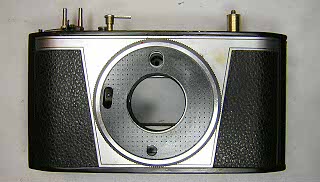 |
The remaining parts of the front are decorative and usually don't need to be removed unless for replacement. However, if you need access to the release shaft, you will need to remove them. The black plate is held in place by a spring clip. Pull the clip out and lift the plate out. |
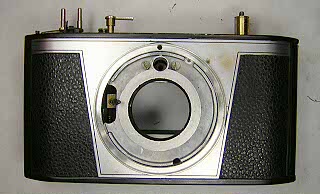 |
Remove the decorative base. |
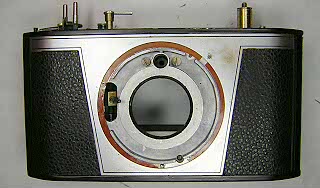 |
The front panel is glued on. Pry it off carefully. The metal is thin brass and is easily bent. Note the plastic shim under the front panel. Be sure to reinstall it. |
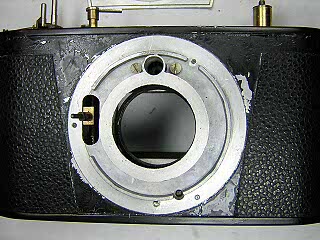 |
The base is held by three screws from the back. Remove the two long screws on the left of the film gate. Note that the screws are slightly different. The third screw is located on the right of the film gate next to the film takeup spool. With the three screws removed you can pry the base off. Don't remove the two screws you see on the front. These hold the bracket that holds the shutter wind pinion against the winder rack. |
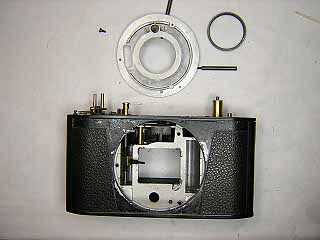 |
This picture shows the front of the camera with all the front pieces removed. |
Notes
If you removed the shutter for cleaning you may find it difficult to get the shutter wind pinion back into place against the winder rack. The rack has to be pulled back towards the rewind shaft while the wind shaft pinion is rotated against the pin on the back of the shutter as far as possible. If the first tooth of the rack doesn't sit on the pinion, the wind stroke will not push the shutter wind shaft far enough to latch. It may be easier to remove the winding parts on top down to the rack so that you can lift the rack up and set it into the proper position. (That's what I had to do anyway.)